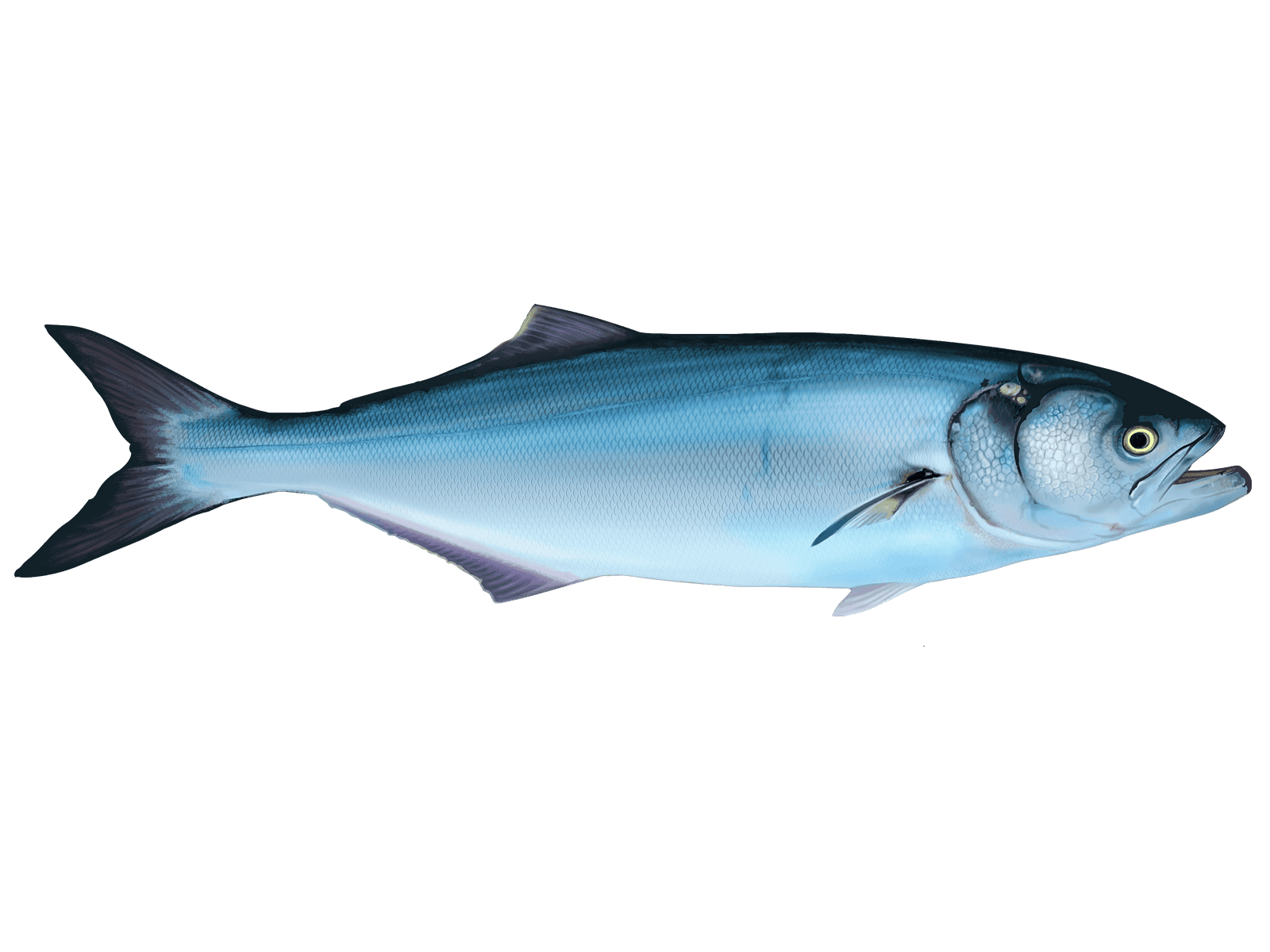Bluefish

Species Details
Pomatomus Saltatrix
Pomatomidae
Perciformes
Nearshore, Onshore
3 - 15 lbs.
15" - 51"
When Do Bluefish Migrate and Where Do They Go?
Bluefish typically migrate during the late summer and fall months. They travel south along the Atlantic Coast from New England to Florida. During their migration, they can be found in nearshore waters, estuaries, and even in the surf zone.
Bluefish (Pomatomus saltatrix) Fish Description
Bluefish is a common game fish that is known for its delicious taste. Bluefish is a warm-water migratory species living in the Atlantic Ocean from Nova Scotia to Argentina and Spain to southern Africa. In South Africa, the Bluefish is known as Shad or Elf; in New Zealand and Australia, it is called Tailor. Bluefish are seasonal visitors to Cape Cod waters, arriving in mid-June and remaining until mid-October. They spend the winter in warmer waters from North Carolina to Florida's tip.
The Bluefish has a moderately proportioned body; one of its distinctive features is its broad and corked tail and its spiny first dorsal and pectoral fins that are usually folded back in a grove. The Bluefish is generally grayish to blue-green in its dorsal area, whereas its belly and lower sides fade to white.
It is a voracious predator with a large mouth and flat, triangular teeth that are strong, sharp, and prominent teeth.
Bluefish Diet
As aggressively strong feeders, the Bluefish have a complex menu of prey. They can chase after schools of forage fish owing to their fast swimming speed. They usually go on a feeding frenzy by attacking these schools of fish even after having satisfied their stomachs. They especially like sardine-like fish, Menhaden, Weakfish, Grunt, Anchovy, Squid, and Shrimp. In return, the Bluefish serve as food for bigger fish like Dolphin, Billfish, Sharks, and Tuna, among others.
Bluefish Size
Commonly, the Bluefish can grow up to 7 inches; they weigh up to 40 lbs. However, most of the Bluefish population reaches only up to 20 lbs.
Interesting Facts About the Bluefish
- The Bluefish is the only remaining living species from the Pomatomidae family. It used to be grouped with Gnomefish, but the latter were separated.
- Lophar miocaenus from Southern California is an extinct relative of the Bluefish from the Late Miocene Period.
- Bluefish are reported to live up to 9 years.
- The Bluefish are cannibalistic, and they sometimes eat their own young.
- The Bluefish are known for churning water like a washing machine, attacking schools in shallow depths. This is called “Bluefish Blitz.”
- Bluefish is a common host to many parasites; in particular, it is often inhabited by the parasite named Philometra saltatrix, which is found in the ovaries of the fish.
- Despite being high in omega-3, children and adult women are warned against consuming Bluefish due to its significant mercury content.
- When properly prepared, bluefish is extremely good to eat, with mild, flaky meat, though larger fish (those weighing more than 10 pounds) have a stronger flavor than their smaller brethren.
Bluefish — Fishing Techniques
To reel in lots of Bluefish, you can use the following harvesting methods: trawls, hook and line, and gillnet. Note that you can only use a circle hook and nothing else; recreational anglers can only capture up to three pieces of Bluefish per day (no minimum size). As for artificial lures or flies, you can use only up to a maximum of two treble hooks. Be careful when handling Bluefish since they can bite you, leading to some serious wounds. Oily fish, such as eels, make excellent bait for bluefish. However, almost any type of baitfish can be used. When learning how to catch bluefish, another option is to use cut bait. Try chunks shaped like a small lure.
You can best fish for Bluefish from tidal rivers, bays, and sandy harbors during summer. In late summer, small, juvenile bluefish known as "baby blues" or "snappers" can be caught in sandy harbors, bays, and tidal rivers. This is an excellent fish for young and inexperienced anglers to catch. Bluefish are frequently caught using gillnets in the commercial bluefish fishery, but they can also be nabbed using a hook, line, or trawl gear.
A permit must be secured to catch Bluefish in commercial fisheries. Some states also impose a specific catch limit for commercial and recreational fishing.
Bluefish Habitat and Distribution
As a marine pelagic fish species, the Bluefish generally inhabit subtropical and temperate waters all around the globe. Most thrive along the continental shelves of America (except in northern South America and south Florida), Australia, and Southeast Asia. Interestingly, the Bluefish is also not found on the north side of the Pacific Ocean.
Typically, anglers find school of Bluefish in various habitats, including brackish waters, estuaries, rock headlands, surf beaches, or above the continental shelf. From time to time, the Bluefish migrate to open waters in schools.
Bluefish fishery management employs a bag limit for recreational fishing and an annual quota distributed to states for commercial fisheries to avoid overfishing.







